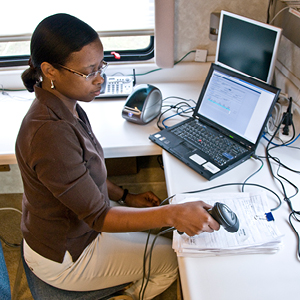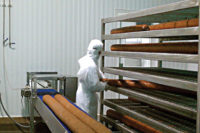
|
By dressing his soldiers in a white tunic with a crimson edge, he was able to see at a glance who was part of his army and who was not. It was an ingenious, practical idea that has since found many uses.
Though the styles, materials and technology have changed considerably over the centuries, the concept of identification by uniform color is now more important than ever. In fact, color-coding has become an industry standard in diverse fields ranging from sports to medicine. It also plays a vital role in the food-processing industry.
Everyone at West Liberty Foods is committed to following and exceeding the industry standards to ensure product safety. This dedication is well-demonstrated in the way in which a progressive color-coded uniform program has become an integral part of the overall approach to food safety and quality assurance. The color-coded uniforms make it easy to spot an individual who is where he or she shouldn’t be. This makes it possible to effectively reduce the risk of cross-contamination and ensure worker safety.
Start at the end
To build a successful color-coding uniform program, you need to first develop a detailed plan for what the desired outcome might look like. Then, you can put together a well thought out implementation plan to make it happen. This approach to building and running a good color-coded program includes four basic elements:
- A well-designed floor plan with an effective color scheme
- An ongoing education program
- Continual updates and upgrades
- Always staying prepared
Because every element is vital to the overall success of the program, it’s important to consider each individually.
1. Combine a clearly defined floorplan with an effective color scheme
It’s important to ensure that each area of activity is kept separate from the others. Creating a clearly defined floorplan helps establish zones, and with the addition of zone-dependent color-coded uniforms, everyone can easily keep track of everyone else and where they should be. By following this protocol, there should never be a reason for anyone to wander into, cross through, or simply be in an area they don’t belong.
Color-coding can be utilized within each zone, as well. For example, at West Liberty Foods, Slice Cells and RTE areas are referred to as “hot zones.” In such hot zones, all workers should wear total encapsulation suits, complete with face masks, boots and hair nets. Those in operations (who actually touch the product) could wear white suits, while those in maintenance (who are never involved in actual production) can wear another color.
2. Maintain an ongoing education plan
Because anyone who enters food-processing facilities is a potential risk to food safety, everyone must follow the color-code guidelines. To ensure this, easy-to-understand charts need to be posted throughout each zone. It is also vital to encourage workers to speak up if they notice a problem or are confused by the guidelines.
For employees, safety training should begin during the first days on the job. They need to learn the details of their specific uniforms and how to properly handle them. For example, those who wear encapsulation suits should be taught to put on their uniforms without allowing the sleeves to touch the floor — a mistake that could cause cross-contamination. Of course, following strict rules like these may be challenging at first. But practicing it on a daily basis not only encourages attention to detail among workers, but also enhances the overall effectiveness of a uniform program.
An effective education plan must extend to non-employees as well. Before entering a facility, all visitors should be given thorough instructions on safety. In addition, they need to always be accompanied by a knowledgeable escort from the company.
3. Update and upgrade regularly
A successful program is not static. All aspects of food safety need to be reassessed with the introduction of each new product or new technology. It’s important to consider even the smallest details.
When adding a new food line — such as dry sausage, for example — you need to isolate the area and install a brush boot-wash system as well as floor foamers at the entrances. In addition, employees should be given specially color-coded aprons and gloves. The same color should be used on the bins for dirty uniforms.
In the future, color-coding will become integral to every new program. It is an important part in developing effective work systems for allergen separation. In an allergen-related system, scoops, spoons and other tools that could potentially come into contact with ingredients would also need to be color-coded.
4. Stay prepared
This is an important element of a continuing successful effort. As in any program, sometimes the simplest things can be the most difficult to manage. In food processing, where many workers change into clean uniforms several times a day, it takes an enormous amount of planning simply to have enough uniforms on hand to meet everyone’s needs. This becomes especially tricky when you need to respond to large orders and put in a multi-shift or seven-day work schedule.
One way to meet this challenge is to work with an effective and trustworthy outside uniform service. Forming a partnership with a vendor who has a structured program that includes prescribed washing temperatures and/or HACCP plans can help to ensure success.
Many vendors now also offer to put a chip into each uniform piece so that the entire pick-up, sanitization and delivery process is easy to monitor. This makes it possible to know how many uniforms you have on hand and how many will be in the next delivery. If you foresee a change in production needs, it’s easy to make certain that there will be enough correctly color-coded clean uniforms on hand.
Similar to other programs in manufacturing environments, you need to continue to review and upgrade color-coded uniform programs on a regular basis. While following the steps recommended by industry standards is important, finding new ways to succeed is even more rewarding. You can never go too far when it comes to food safety.




Report Abusive Comment